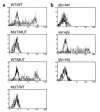Familial CD8 deficiency due to a mutation in the CD8 alpha gene
- PMID: 11435463
- PMCID: PMC209336
- DOI: 10.1172/JCI10993
Familial CD8 deficiency due to a mutation in the CD8 alpha gene
Abstract
CD8 glycoproteins play an important role in both the maturation and function of MHC class I-restricted T lymphocytes. A 25-year-old man, from a consanguineous family, with recurrent bacterial infections and total absence of CD8(+) cells, was studied. Ab deficiencies and ZAP-70 and TAP defects were ruled out. A missense mutation (gly90-->ser) in both alleles of the immunoglobulin domain of the CD8 alpha gene was shown to correlate with the absence of CD8 expression found in the patient and two sisters. Conversely, high percentages of CD4(-)CD8(-)TCR alpha beta(+) T cells were found in the three siblings. A novel autosomal recessive immunologic defect characterized by absence of CD8(+) cells is described. These findings may help to further understanding of the role of CD8 molecules in human immune response.
Figures




Similar articles
-
T cell development in a major histocompatibility complex class II-deficient patient.Eur J Immunol. 1993 Oct;23(10):2585-91. doi: 10.1002/eji.1830231031. Eur J Immunol. 1993. PMID: 8405058
-
β2-Microglobulin deficiency causes a complex immunodeficiency of the innate and adaptive immune system.J Allergy Clin Immunol. 2015 Aug;136(2):392-401. doi: 10.1016/j.jaci.2014.12.1937. Epub 2015 Feb 19. J Allergy Clin Immunol. 2015. PMID: 25702838
-
Gly111Ser mutation in CD8A gene causing CD8 immunodeficiency is found in Spanish Gypsies.Mol Immunol. 2008 Jan;45(2):479-84. doi: 10.1016/j.molimm.2007.05.022. Epub 2007 Jul 20. Mol Immunol. 2008. PMID: 17658607
-
A novel mutation in the dihydrolipoamide dehydrogenase E3 subunit gene (DLD) resulting in an atypical form of alpha-ketoglutarate dehydrogenase deficiency.Hum Mutat. 2005 Mar;25(3):323-4. doi: 10.1002/humu.9319. Hum Mutat. 2005. PMID: 15712224 Review.
-
The CD8 T cell response to staphylococcal enterotoxins.Semin Immunol. 1993 Feb;5(1):33-9. doi: 10.1006/smim.1993.1005. Semin Immunol. 1993. PMID: 8467093 Review.
Cited by
-
IL-21 can supplement suboptimal Lck-independent MAPK activation in a STAT-3-dependent manner in human CD8(+) T cells.J Immunol. 2012 Feb 15;188(4):1609-19. doi: 10.4049/jimmunol.1003446. Epub 2012 Jan 11. J Immunol. 2012. PMID: 22238455 Free PMC article.
-
Structure, function, and immunomodulation of the CD8 co-receptor.Front Immunol. 2024 Aug 26;15:1412513. doi: 10.3389/fimmu.2024.1412513. eCollection 2024. Front Immunol. 2024. PMID: 39253084 Free PMC article. Review.
-
Partial defects of T-cell development associated with poor T-cell function.J Allergy Clin Immunol. 2013 May;131(5):1297-305. doi: 10.1016/j.jaci.2013.01.020. Epub 2013 Mar 5. J Allergy Clin Immunol. 2013. PMID: 23465662 Free PMC article. Review.
-
Preoperative treatment with a non-steroidal anti-inflammatory drug (NSAID) increases tumor tissue infiltration of seemingly activated immune cells in colorectal cancer.Cancer Immun. 2008 Feb 29;8:5. Cancer Immun. 2008. PMID: 18307280 Free PMC article. Clinical Trial.
-
Modulation of Dietary Fatty Acids in an Open-Label Study Improves Psoriasis and Dampens the Inflammatory Activation Status.Nutrients. 2023 Mar 30;15(7):1698. doi: 10.3390/nu15071698. Nutrients. 2023. PMID: 37049538 Free PMC article.
References
-
- Townsend A, Bodmer H. Antigen recognition by class I-restricted T lymphocytes. Annu Rev Immunol. 1989;7:601–624. - PubMed
-
- Zinkernagel RM, Doherty PC. MHC-restricted cytotoxic T cells: studies on the biological role of polymorphic major transplantation antigens determining T cell restriction-specificity function and responsiveness. Adv Immunol. 1979;27:51–77. - PubMed
-
- Tanaka K, Yoshioka T, Bieberich C, Jay G. Role of the major histocompatibility complex class I antigens in tumor growth and metastasis. Annu Rev Immunol. 1998;6:359–380. - PubMed
-
- Mason DW, Morris PJ. Effector mechanisms in allograft rejection. Annu Rev Immunol. 1986;4:119–145. - PubMed
-
- Janeway CA. The T cell receptor as a multicomponent signalling machine: CD4/CD8 coreceptors and CD45 in T cell activation. Annu Rev Immunol. 1992;10:645–674. - PubMed
Publication types
MeSH terms
Substances
Associated data
- Actions
LinkOut - more resources
Full Text Sources
Other Literature Sources
Molecular Biology Databases
Research Materials
Miscellaneous

